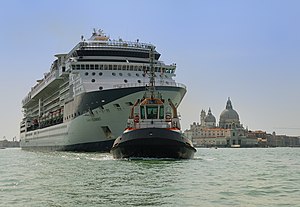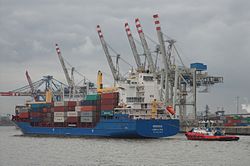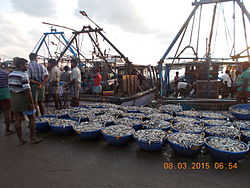Proposal:Seaway
| Seaway for sea transport related features like ports | |
|---|---|
| Proposal status: | Proposed (under way) |
| Proposed by: | dieterdreist |
| Tagging: | seaway=* |
| Applies to: | |
| Definition: | a key for features related to the navigation at sea |
| Statistics: |
|
| Draft started: | 2017-02-21 |
| RFC start: | 2021-03-05 |
Proposal
This is a proposal to introduce a new key with a sea transport related scope. In this first iteration the proposal deals mostly with ports, which are the backbone of transport on the oceans. Feel free to add your own ideas on the discussion page. You are invited to use these tags if you find them helpful.
Rationale
Currently there is an appearent lack of tagging structure in this field. Features can be found in keys like seamark=* or implicitly by looking at landuse (industrial=*, a landuse subtag), but, with few structure and some gaps in the scheme, we currently miss a lot of interesting information and details about the infrastructure for navigating the seas (e.g. compare global tag usage numbers of airports to those of seaports).
This could have also been something in an established key like man_made=* or amenity=*, but if you look at the whole OSM tagging scheme, you can see that all similar (transportation infrastructure related) features have their own key: highway=*, railway=*, aeroway=*, aerialway=*, waterway=* and it seems logical to introduce the missing link for sea based transport.
Tagging
Ports
Ports are very important for sea based transport. To map a port, use the key seaway=* with one of these values port, cargo_port, cruise_port, ferry_port, fishing_port (see below for more information) and add other relevant tags like:
If you are not sure which case applies or for combined ports, use seaway=port for the combined port/as a generic port and use different objects to tag the specific parts. Add subkeys according to the kind of facility you are dealing with (see below).
Terminals
Within port areas, you often find terminals. In any port there can be many terminals, e.g. container terminals for the handling of cargo, ferry terminals to embark and get off a ferry.
Passenger ports
| tag | description | foto |
|---|---|---|
| seaway=ferry_port | for ferry ports. In every port you can have several amenity=ferry_terminal | |
| seaway=cruise_port | for cruise ports and terminals. |
Useful subkeys
For combined ports use the most important function for the main tag (seaway=*_port) and add the subkeys for further detail.
- cruise_port=yes/home_port/terminal/port_of_call use home_port in all combined cases where it is a home port for at least one ship, and similarly terminal if it is not a home port but a terminal.
- home_port means it is the home port of at least one cruise route
- terminal means it is a route endpoint of a cruise router but not a home port
- port_of_call means it is a port where cruise ships take intermediate stops.
Subkeys for routes
If routes are mapped, you could use these roles for the ports in the route:
Cargo ports
Use seaway=cargo_port for all kind of cargo ports.
Properties to describe cargo handling capabilities
These capability tags can be added to entire ports or specific parts of ports where this kind of cargo is dealt with.
| tag | description | foto |
|---|---|---|
| cargo:container=yes/no | port can handle standard cargo containers | |
| cargo:bulk=yes/no | port is able to handle bulk cargo, i.e. stuff that isn't packaged, typically granular) | |
| cargo:liquids=yes/no | port for the handling of liquid cargo | |
| cargo:gas=yes/no | port for the handling of gaseous cargo | |
| cargo:break_bulk=yes/no | port is handling break bulk cargo, stuff that has to be handled individually, e.g. cars, bags, boxes, barrels, crates, drums | |
| cargo:heavy-lift=yes/no | port can handle heavy-lift cargo, e.g. plant components |
See also
- amenity=ferry_terminal established tag for ferry terminals
- leisure=marina established for marinas
Fishing ports
| tag | description | foto |
|---|---|---|
| seaway=fishing_port | for a fishing port by the sea. |
Use historic=fishing_port for historic fishing ports that are not used any more.
Inland ports
Use inland_port=yes/no together with a seaway=* port type (see above) for inland port facilities that handle ocean-going vessels.
Use waterway=port for inland ports like river ports and ports at lakes for river traffic, such as barges and other shallow-draft vessels
External discussions
On the tagging ML: [1]
See also
- leisure=marina
- Harbour overview page
- the Seamarks/Seamark Tag Values "specialist tagging"
Discussion mentions
Comments
Please comment on the discussion page.









